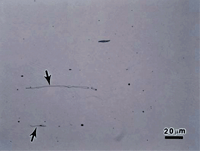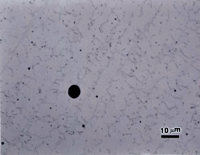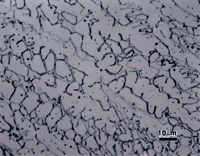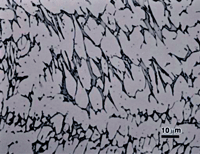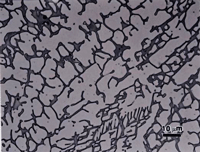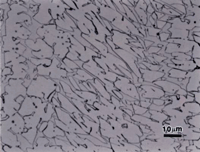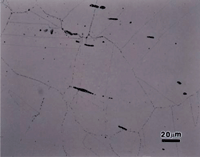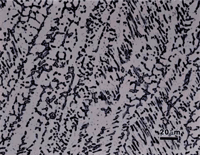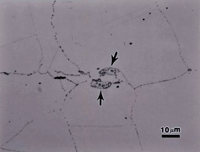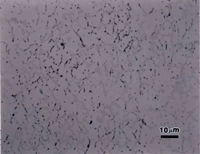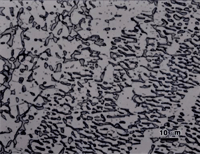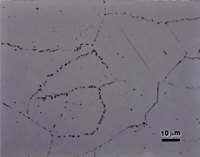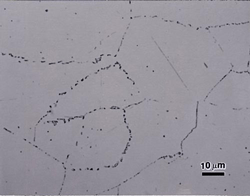Abstract
Numerous etchants have been used to selectively reveal matrix phases and second-phase constituents in ferritic, martensitic, ferritic-martensitic, austenitic, ferritic-austenitic (duplex) and precipitation hardenable stainless steels. Procedures for identification of second-phases, such as carbides, sigma and chi, and delta ferrite in austenitic or precipitation hardenable stainless steels using selective etchants are described.
Introduction
The microstructural constitution of stainless steel is quite complex and exposure to high operating temperatures adds to the complexity as a variety of phases can be observed. In addition to the matrix phases of ferrite, austenite and martensite, and duplex austenite-ferrite and (less commonly) ferrite-martensite, there are numerous possible minor constituents. In the carbide family, M23C6 (face-centered cubic) and M7C3 (hexagonal) carbides are the most common, but M6C (face-centered cubic) and MC (face-centered cubic) carbides, are also observed in certain alloys. Certain nitrides may be observed and the intermetallic phases, sigma, σ (tetragonal), chi, χ (body-centered cubic) and Laves, η (hexagonal). Much has been published regarding selective etching techniques to differentiation sigma from ferrite, or delta ferrite, and for the various carbides, but little has been published regarding chi and Laves. These two constituents are observed only in a few alloys and under specific conditions.
Despite the fact that some of these constituents have non-cubic crystal structures, they do not respond well to polarized light and that mode of observation is not useful for discrimination purposes. Nomarski DIC may be of some use to see which constituents are harder than the matrix, but this is, at best, of limited help. The best techniques for identifying phases and constituents are diffraction, either x-ray diffraction of extracted residues or convergent-beam electron diffraction using extraction replicas or thin foils. Both methods are slow and require expensive equipment. WDS or EDS analysis can be very helpful once these methods are used on well-characterized specimens (previously studied by diffraction methods), but they also require expensive equipment. Consequently, there has been a long history of interest in identifying these phases and constituents by light microscopic examination.
Experimental Program
Specimens of type 316 austenitic stainless steel that were welded with type 312 weld rod, designed to produce about 12-15% delta ferrite in the weldment, were obtained for the study. The plate was welded from each side using a total of four passes. A section was aged at 816 ºC (1500 ºF) for 160 hours (and slow cooled to ambient) to convert the delta ferrite to sigma and also to sensitize the specimen by precipitating carbide at the grain boundaries.
The specimens were mounted and prepared metallographically. Each was etched with the reagents described below. They were re-prepared between etchants. The etchants used were as follows.
- Vilella’s reagent (1 g picric acid, 4 mL HCl, 96 mL ethanol), used by swabbing for 10-20 s. This outlined the delta and the sigma and revealed the carbides in the austenite grain boundaries of the base metal and in the weldment. The sigma phase was more sharply outlined than the delta ferrite. No austenite grain boundaries were revealed.
- Murakami’s reagent (10 g KOH or NaOH, 10 g potassium ferricyanide, 100 mL water), used at room temperature or between 80 and 100 ºC. At room temperature, carbides can be revealed at the austenite grain boundaries and within the weldment. When used at or near the boiling point, both delta and sigma are revealed. Delta is not as clearly revealed as sigma. With KOH, sigma was colored orange-brown in 30 s, but after another 30 s nearly all of the color was gone. With NaOH, sigma was colored orange-brown after 60 s. The delta ferrite was colored better using NaOH than with KOH (very weak).
- 20% NaOH in water at 3 V dc, 10 s, used to color both delta ferrite (tan/blue) and sigma (orange-brown). Carbides were visible but not strongly revealed.
- 10% ammonium persulfate in water at 6 V dc, 10 s, was used to color the carbides. Contrast was slightly better than with Vilella’s, but both were excellent for revealing the carbides. This etch outlined both the delta ferrite and the sigma phase. Again, the sharpness of the phase boundaries was excellent for sigma and non-uniform for the delta ferrite.
- Concentrated ammonium hydroxide at 1.5 V dc and at 6 V dc for 60 s, was used in an effort to reveal the structure. At 1.5 V dc, the carbides were revealed faintly after 60 s. At 6 V dc, the carbides were visible after 60 s but not with the contrast produced by Vilella’s or ammonium persulfate. Sigma was not colored. A stainless steel cathode was used for all electrolytic etching.
Microstructures
The as-welded specimen was not sensitized and carbide was not observed in the base metal. However, some small, elongated particles of delta ferrite were observed in the type 316 base metal. This is illustrated in Figure 1 after etching with Vilella’s reagent. Some carbide was present in the weld. Figure 2 shows the carbide, plus some slag inclusions (note the very large one shown) after etching at room temperature for 60 s with Murakami’s reagent.
The delta ferrite is shown in Figures 3 a, b, c and d after etching with Vilella’s reagent, Murakami’s reagent (boiling, 3 min), 20% NaOH (3 V dc, 10 s), and 10% ammonium persulfate (6 V dc, 10 s), respectively. Note that the latter etch only outlined the delta ferrite, and that was a bit non-uniform. Electrolytic sodium hydroxide produced the most uniform results with the best sharpness and contrast and is highly recommended for this purpose.
The microstructure of the aged specimen is slightly more complex as the weldment contains sigma and carbide and the base metal was sensitized and exhibits M23C6 carbide on the grain and twin boundaries. Several etchants revealed the carbides well. Vilella’s reagent revealed the carbides very clearly and with good contrast, and outlined the sigma phase very clearly. The sharpness and uniformity of the outlining was much better than for the delta ferrite. The small patches of delta ferrite that were observed in the 316 base metal were converted to sigma by the aging treatment and they appear quite differently now when etched with Vilella’s, Figure 4 (compare with Figure 1). One stringer is in the upper right corner of the image. The other large precipitates are sulfide inclusions. The grain and twin boundaries have been nearly fully covered by the carbide that precipitated in the post-welding heat treatment. Besides the intergranular carbide there is some intragranular carbide. Vilella’s reagent outlined the sigma in the weldment, Figure 5, and the phase boundaries are sharper than for the delta ferrite, Figure 3 a. The large black round particles in Figure 5 are slag particles. The smaller, dark particles in the austenitic matrix are carbides.
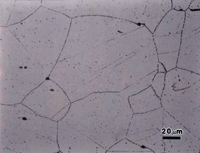 |
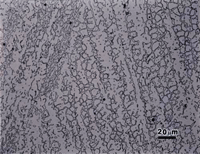 |
| Figure 4. Grain boundary sensitization in aged specimen revealed by Vilella’s. | Figure 5. Delta ferrite in aged specimen revealed using Vilella’s reagent. |
20% sodium hydroxide in water at 3 V dc, 10 s, was excellent for revealing the sigma phase in the aged specimen, but produced somewhat weaker contrast for the grain boundary carbides. Figure 6 shows the 316 base metal and the small delta ferrite stringers in the base metal are clearly visible. The grain boundary carbides are visible but not as strongly as with Vilella’s. Figure 7 shows the sigma phase in the 312 weldment, colored orange brown and revealed sharply.
Murakami’s reagent at room temperature revealed the carbides in both the aged base metal and the weldment, but not the sigma. Figure 8 shows the base metal. Note the regions marked with the arrows that contain some larger carbides. Because neither sigma nor delta ferrite were revealed in the as-welded or aged specimens with room temperature aging, it is assumed that these particles are carbides. Figure 9 shows the carbides revealed in the weldment. This is useful as many other etchants also revealed the sigma, which makes it harder to see the carbides in the weldment.
Murakami’s used at 80-100 ºC revealed sigma phase with an orange-brown color. Figure 10 shows the sigma using NaOH in the formulation. When KOH was used, the sigma was colored in similar manner after 30 s but with an additional 30 s etch, the color was largely removed. The use of NaOH vs KOH in Murakami’s needs to be studied further. They are generally considered to be equivalent. Future work will also evaluate the 20/20/100 and 30/30/100 versions of Murakami’s.
10% ammonium persulfate at 6 V dc, 10 s, is an excellent etch for revealing sensitization and it again proved to be quite useful for this purpose as shown by Figure 11. This shows well-revealed carbides in the aged 316 base metal. Figure 12 shows that ammonium persulfate outlined sigma quite nicely, but did not color it. Note that the outlining is much sharper and more uniform than it was for the delta ferrite (Figure3d).
The final example is the use of concentrated ammonium hydroxide electrolytically. Results were no better than for other more easily used reagents and, because of the strong pungent odor of ammonium hydroxide and the irritation of the hands, eyes, nose and throat, its use is not recommended. It did reveal the carbides in the sensitized 316 base metal, but not as well as Vilella’s or ammonium persulfate. In this use, the sigma was not revealed, although in prior use, it was (different specimen).
Conclusions
The study revealed that a variety of reagents can be used to reveal constituents in stainless steels. Vilella’s reagent, and other similar general purpose reagents, will reveal the carbides but will only outline delta ferrite and sigma. They are not useful for identification purposes. Electrolytic 20% NaOH was excellent for revealing and discriminating between delta ferrite and sigma as it colored delta ferrite tan and blue and sigma orange. Murakami’s works well, but gave some erratic results. At room temperature it only reveals the carbide, but not as clearly as Vilella’s or ammonium persulfate. At temperatures near the boiling point, the standard formulation colored delta ferrite non-uniformly and sigma uniformly. But there was no color difference. Ammonium persulfate is excellent for detecting sensitization as it reveals the carbides very clearly. It outlined both delta ferrite and sigma. Again, the delta ferrite was not sharply outlined but the sigma was. Ammonium hydroxide is not recommended for use as it did nothing better than any other etch and it is very annoying to use. Future work needs to examine the use of KOH vs NaOH in the standard Murakami’s etch and try the higher concentration versions.
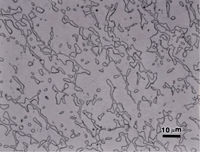 |
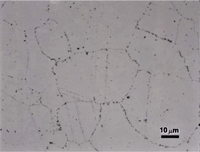 |
| Figure 12. Sigma in aged 312 weld metal outlined using ammonium persulfate. | Figure 13. Carbides in aged 316 base metal revealed using ammonium hydroxide. |
The microstructural constitution of stainless steels is quite complex, and exposure to high operating temperatures adds to the complexity as a variety of phases can occur. In addition to the matrix phases of ferrite, austenite and martensite, as well as duplex austenite-ferrite and (less commonly) ferrite-martensite, there are numerous possible minor constituents. In the carbide family, M23C6 (face-centered cubic) and M7C3 (hexagonal) carbides are the most common, but M6C (face-centered cubic) and MC (face-centered cubic) carbides are also observed in certain alloys. Nitrides may be observed in the intermetallic phases: sigma (σ – tetragonal), chi (χ – body-centered cubic) and Laves (η – hexagonal). Much has been published regarding selective etching techniques to differentiate sigma from ferrite, or delta ferrite, and for the various carbides, but little has been published regarding chi and Laves. These two constituents are observed only in a few alloys and under specific conditions.
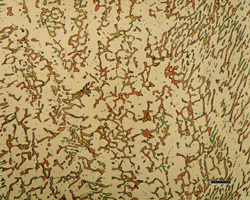 |
| Fig. 1. Aged 312 stainless steel weld metal where the sigma phase was colored by etching with Murakami’s reagent at 80°C. The magnification bar is 20 µm long |
Although some of these constituents have non-cubic crystal structures, they do not respond well to polarized light, and that mode of observation is not useful for discrimination purposes. Nomarski DIC may be of some use to see which constituents are harder or softer than the matrix, but this is of limited help. The best techniques for identifying phases and constituents are diffraction – either X-ray diffraction of extracted residues or convergent-beam electron diffraction using extraction replicas or thin foils. Both methods are slow and require expensive equipment. WDS or EDS analysis can be very helpful once these methods are used on well-characterized specimens. Electron backscattered diffraction (EBSD) can also be used to identify phases. But, WDS, EDS and EBSD all require particles bigger than the beam diameter (>~2 µm) for analysis. Consequently, there has been a long history of interest in identifying these phases and constituents by light microscopic examination.
Specimens of type 316 austenitic stainless steel were welded with type 312 weld rod, designed to produce about 12-15% delta ferrite in the weld nugget. The plate was welded from each side using a total of four passes. A section was aged at 816°C (1500°F) for 160 hours (and slow cooled to ambient) to convert the delta ferrite to sigma and also to sensitize the specimen by precipitating carbide at the grain boundaries.
The specimens were mounted and prepared metallographically. Each was etched with the reagents described below. They were re-prepared between etchants. The etchants used were as follows.
1. Vilella’s reagent (1 g picric acid, 4 mL HCl, 96 mL ethanol), used by swabbing for 10-20 s. This outlined the delta and the sigma and revealed the carbides in the austenite grain boundaries of the base metal and in the weld. Sigma phase was more sharply outlined than the delta ferrite. No austenite grain or twin boundaries were revealed.
2. Murakami’s reagent (10 g KOH or NaOH, 10 g potassium ferricyanide, 100 mL water), used at room temperature or 80-100ºF. At room temperature, carbides can be revealed at the austenite grain boundaries and within the weld. When used at or near the boiling point, both delta and sigma are revealed. Delta is not as clearly revealed as sigma. With KOH, sigma was colored orange-brown in 30 s, but after another 30 s nearly all of the color was gone. With NaOH, sigma was colored orange-brown after 60 s. The delta ferrite was colored better using NaOH than with KOH (very weak).
3. 20% NaOH in water at 3 V dc, 10 s, used to color both delta ferrite (tan/blue) and sigma (orange-brown). Carbides were visible but not strongly revealed.
4. 10% ammonium persulfate in water at 6 V dc, 10 s, was used to color the carbides. Contrast was slightly better than with Vilella’s, but both were excellent for revealing the carbides. This etch outlined both the delta ferrite and the sigma phase. Again, the sharpness of the phase boundaries was excellent for sigma and non-uniform for the delta ferrite.
5. Concentrated ammonium hydroxide at 1.5 V dc and at 6 V dc for 60 s, was used in an effort to reveal the structure. At 1.5 V dc, the carbides were revealed faintly after 60 s. At 6 V dc, the carbides were visible after 60 s but not with the contrast produced by Vilella’s or ammonium persulfate. Sigma was not colored. A stainless steel cathode was used for all electrolytic etching.
The study showed that a variety of reagents can be used to reveal constituents in stainless steels. Vilella’s reagent, and other similar general-purpose reagents, will reveal the carbides but will only outline delta ferrite and sigma. They are not useful for identification purposes. Electrolytic 20% NaOH was excellent for revealing and discriminating between delta ferrite and sigma as it colored delta ferrite tan and blue and sigma orange. Murakami’s works well, but it gave some erratic results. At room temperature, it only reveals the carbide but not as clearly as Vilella’s or ammonium persulfate. At temperatures near the boiling point, the standard formulation colored the delta ferrite non-uniformly but colored sigma uniformly. But there was no color difference. Ammonium persulfate is excellent for detecting sensitization because it reveals the carbides very clearly. It outlined both delta ferrite and sigma. Again, the delta ferrite was not sharply outlined but the sigma was. Ammonium hydroxide is not recommended for use as it did nothing better than any other etch, and it is very annoying to use.
Figure 1 shows 312 SS that was aged at 816°C for 160 h converting all of the ferrite to sigma. The specimen was etched with Murakami’s reagent at 80°C, coloring the sigma vividly. Figure 2 shows sensitization – carbides precipitated in the grain boundaries of the welded 316 stainless steel in the heat-affected zone – revealed very well using aqueous 10% ammonium persulfate electrolytically.
George Vander Voorthas a background in physical, process and mechanical metallurgy and has been performing metallographic studies for 43 years. He is a long-time member of ASTM Committee E-4 on metallography and has published extensively in metallography and failure analysis. He regularly teaches MEI courses for ASM International and is now doing webinars. He is a consultant for Struers Inc. and will be teaching courses soon for them. He can be reached at 1-847-623-7648, EMAIL: georgevandervoort (AT) yahoo (DOT) com and through his web site: www.georgevandervoort.com
To View a listing of all George’s articles please click here
Read George Vander Voort’s Biography

